Effect of AQM-Based RLC Buffer Management on the eNB Scheduling Algorithm in LTE Network †
Abstract
:1. Introduction
- In this paper, we have extended our idea Smart RED (SmRED) [7] to SmRED-i, where packet dropping probability function is different in accordance with the value of i = Increasing the value of i will lead to lower dropping probability during low traffic-load condition and high dropping probability during high traffic-load condition. We can tune the parameter i to get different dropping functions.
- We overview the effect of AQM-based buffer management on the performance of different scheduling algorithms with and without handover. We measured the performance in terms of end-to-end average Transmission Control Protocol (TCP) throughput and delay. While there is significant work on the performance of different schedulers in the absence of AQM-based buffer management [4] and handover [8], it is very difficult to capture the effect of both on the scheduling algorithms using analytical models.
- Finally, we used detailed and extensive ns3 [9] realistic simulation to simulate the effect of AQM-based buffer management on the scheduling algorithms in the single cell network topology without handover and in the multi-cell network topology in the presence of handover in LTE networks across a wide range of traffic-loads.
2. Related Work
3. Background
3.1. Overview of LTE Networks
3.2. Radio Resource Management
4. Active Queue Management and Proposed Approach
5. Network Model
5.1. Network Topology and System Parameters
5.2. Scheduling Algorithms
6. Simulation Result and Performance Evaluation
7. Conclusions
Acknowledgments
Author Contributions
Conflicts of Interest
References
- Zhao, X.; Lin, H.; Zhang, M. 3GPP Long Term Evolution: Architecture and Specification; Post and Telecom Press: Beijing, China, 2010. [Google Scholar]
- Toseef, U.; Weerawardane, T.; Timm-Giel, A.; Gorg, C. LTE system performance optimization by discard timer based PDCP buffer management. In Proceedings of the IEEE 8th International Conference on High-capacity Optical Networks and Emerging Technologies, Riyadh, Saudi Arabia, 19–21 December 2011; pp. 116–121. [Google Scholar]
- Zheng, Y.; Yu, Q.; Meng, W.; Li, C. A red-based discard strategy for unacknowledged mode RLC in LTE. In Proceedings of the 2013 IEEE Global Communications Conference (GLOBECOM), Atlanta, GA, USA, 9–13 December 2013; pp. 4753–4758. [Google Scholar]
- Shojaedin, N.; Ghaderi, M.; Sridharan, A. Effect of handover on the performance of scheduling algorithms in LTE networks. In Proceedings of the 2015 IEEE Wireless Communications and Networking Conference (WCNC), New Orleans, LA, USA, 9–12 March 2015; pp. 1386–1391. [Google Scholar]
- General Packet Radio Service (GPRS) Enhancements for Evolved Universal Terrestrial Radio Access Network (E-UTRAN) Access. Available online: http://www.etsi.org/deliver/etsi_ts/123400_123499/123401/08.14.00_60/ts_123401v081400p.pdf (accessed on 1 September 2011).
- Floyd, S.; Jacobson, V. Random Early Detection Gateways for Congestion Avoidance. IEEE/ACM Trans. Netw. 1993, 1, 397–413. [Google Scholar] [CrossRef]
- Paul, A.K.; Kawakami, H.; Tachibana, A.; Hasegawa, T. An AQM based congestion control for eNB RLC in 4G/LTE network. In Proceedings of the 2016 IEEE Canadian Conference on Electrical and Computer Engineering (CCECE), Vancouver, BC, Canada, 15–18 May 2016; pp. 1–5. [Google Scholar]
- Bouchemal, N.; Izri, N.; Tohme, S. MAC-LTE scheduler modeling and performance evaluation in LTE network. In Proceedings of the 2014 IEEE 25th Annual International Symposium on Personal, Indoor, and Mobile Radio Communication (PIMRC), Washington, DC, USA, 2–5 September 2014; pp. 1007–1012. [Google Scholar]
- The Network Simulator ns-3. Available online: https://www.nsnam.org (accessed on 23 March 2016).
- Feng, C.W.; Huang, L.F.; Xu, C.; Chang, Y.C. Congestion Control Scheme Performance Analysis Based on Nonlinear RED. IEEE Syst. J. 2015, 1–8. [Google Scholar] [CrossRef]
- Floyd, S.; Fall, K. Promoting the Use of End-to-end Congestion Control in the Internet. IEEE/ACM Trans. Netw. 1999, 7, 458–472. [Google Scholar] [CrossRef]
- Feng, W.C.; Kandlur, D.D.; Saha, D.; Shin, K.G. A self-configuring RED gateway. In Proceedings of the Eighteenth Annual Joint Conference of the IEEE Computer and Communications Societies (INFOCOM ’99), New York, NY, USA, 21–25 March 1999; Volume 3, pp. 1320–1328. [Google Scholar]
- Jacobson, V.; Nichols, K.; Poduri, K. RED in a Different Light; Technical Report; Cisco Systems: San Jose, CA, USA, 1999. [Google Scholar]
- Hu, L.; Kshemkalyani, A.D. HRED: A simple and efficient active queue management algorithm. In Proceedings of the 13th International Conference on Computer Communications and Networks (IEEE Cat. No.04EX969), Chicago, IL, USA, 11–13 October 2004; pp. 387–393. [Google Scholar]
- Park, E.C.; Lim, H.; Park, K.J.; Choi, C.H. Analysis and design of the virtual rate control algorithm for stabilizing queues in TCP networks. Comput. Netw. 2004, 44, 17–41. [Google Scholar] [CrossRef]
- Lin, D.; Morris, R. Dynamics of Random Early Detection. SIGCOMM Comput. Commun. Rev. 1997, 27, 127–137. [Google Scholar] [CrossRef]
- Ott, T.J.; Lakshman, T.V.; Wong, L.H. SRED: Stabilized RED. In Proceedings of the Eighteenth Annual Joint Conference of the IEEE Computer and Communications Societies ( INFOCOM ’99), New York, NY, USA, 21–25 March 1999; Volume 3, pp. 1346–1355. [Google Scholar]
- Anjum, F.M.; Tassiulas, L. Fair bandwidth sharing among adaptive and non-adaptive flows in the Internet. In Proceedings of the Eighteenth Annual Joint Conference of the IEEE Computer and Communications Societies ( INFOCOM ’99), New York, NY, USA, 21–25 March 1999; Volume 3, pp. 1412–1420. [Google Scholar]
- Feng, W.C.; Shin, K.G.; Kandlur, D.D.; Saha, D. The BLUE Active Queue Management Algorithms. IEEE/ACM Trans. Netw. 2002, 10, 513–528. [Google Scholar] [CrossRef]
- Long, C.; Zhao, B.; Guan, X.; Yang, J. The Yellow active queue management algorithm. Comput. Netw. 2005, 47, 525–550. [Google Scholar] [CrossRef]
- Firoiu, V.; Borden, M. A study of active queue management for congestion control. In Proceedings of the IEEE Conference on Nineteenth Annual Joint Conference of the IEEE Computer and Communications Societies (Cat. No.00CH37064), Tel Aviv, Israel, 26–30 March 2000; Volume 3, pp. 1435–1444. [Google Scholar]
- Hollot, C.V.; Misra, V.; Towsley, D.; Gong, W.B. On designing improved controllers for AQM routers supporting TCP flows. In Proceedings of the IEEE Conference on Twentieth Annual Joint Conference of the IEEE Computer and Communications Society (Cat. No.01CH37213), Anchorage, AK, USA, 22–26 April 2001; Volume 3, pp. 1726–1734. [Google Scholar]
- Sun, J.; Ko, K.T.; Chen, G.; Chan, S.; Zukerman, M. PD-RED: To improve the performance of RED. IEEE Commun. Lett. 2003, 7, 406–408. [Google Scholar]
- Yanfie, F.; Fengyuan, R.; Chuang, L. Design a PID controller for active queue management. In Proceedings of the Eighth IEEE Symposium on Computers and Communications (ISCC 2003), Kemer-Antalya, Turkey, 30 June–3 July 2003; Volume 2, pp. 985–990. [Google Scholar]
- Singh, P.K.; Gupta, S.K. Variable length virtual output queue based fuzzy congestion control at routers. In Proceedings of the 2011 IEEE 3rd International Conference on Communication Software and Networks, Xi’an, China, 27–29 May 2011; pp. 29–33. [Google Scholar]
- Karbowski, A. Comments on “Optimization flow control .I. Basic algorithm and convergence”. IEEE/ACM Trans. Netw. 2003, 11, 338–339. [Google Scholar] [CrossRef]
- Athuraliya, S.; Low, S.H.; Li, V.H.; Yin, O. REM: Active queue management. IEEE Netw. 2001, 15, 48–53. [Google Scholar] [CrossRef]
- Kunniyur, S.S.; Srikant, R. An adaptive virtual queue (AVQ) algorithm for active queue management. IEEE/ACM Trans. Netw. 2004, 12, 286–299. [Google Scholar] [CrossRef]
- Deng, X.; Yi, S.; Kesidis, G.; Das, C.R. Stabilized virtual buffer (SVB)—An active queue management scheme for Internet quality-of-service. In Proceedings of the IEEE Global Telecommunications Conference (GLOBECOM ’02), Taipei, Taiwan, 17–21 November 2002; Volume 2, pp. 1628–1632. [Google Scholar]
- Adams, R. Active Queue Management: A Survey. IEEE Commun. Surv. Tutor. 2013, 15, 1425–1476. [Google Scholar] [CrossRef]
- Alasem, R.; Abu-Mansour, H. EF-AQM: Efficient and Fair Bandwidth Allocation AQM Scheme for Wireless Networks. In Proceedings of the 2010 2nd International Conference on Computational Intelligence, Communication Systems and Networks, Liverpool, UK, 28–30 July 2010; pp. 169–172. [Google Scholar]
- Alcaraz, J.J.; Cerdan, F. Using buffer management in 3G radio bearers to enhance end-to-end TCP performance. In Proceedings of the 20th International Conference on Advanced Information Networking and Applications (AINA’06), Vienna, Austria, 18–20 April 2006; Volume 2, p. 5. [Google Scholar]
- Jun, L.; Wu, Y.; Suili, F.; Hua, G.; Hongcheng, Z. A Cross-Layer Queue Management Algorithm in 802.16 Wireless Networks. In Proceedings of the 2009 International Conference on Communication Software and Networks, Macau, China, 27–28 February 2009; pp. 25–29. [Google Scholar]
- Kumar, K.D.; Ramya, I.; Masillamani, M.R. Queue Management in Mobile Adhoc Networks (Manets). In Proceedings of the Green Computing and Communications (GreenCom), 2010 IEEE/ACM Int’l Conference on Int’l Conference on Cyber, Physical and Social Computing (CPSCom), Hangzhou, China, 18–20 December 2010; pp. 943–946. [Google Scholar]
- Abbasov, B. AHRED: A robust AQM algorithm for wireless ad hoc networks. In Proceedings of the 2009 International Conference on Application of Information and Communication Technologies, Baku, Azerbaijan, 14–16 October 2009; pp. 1–4. [Google Scholar]
- Sesia, S.; Toufik, I.; Baker, M. LTE—The UMTS Long Term Evolution:From Theory to Practice; Wiley: New York, NY, USA, 2011. [Google Scholar]
- Capozzi, F.; Piro, G.; Grieco, L.A.; Boggia, G.; Camarda, P. Downlink Packet Scheduling in LTE Cellular Networks: Key Design Issues and a Survey. IEEE Commun. Surv. Tutor. 2013, 15, 678–700. [Google Scholar] [CrossRef]
- Shorten, R.; King, C.; Wirth, F.; Leith, D. Modeling TCP congestion control dynamics in drop-tail environments. Automatica 2007, 43, 441–449. [Google Scholar] [CrossRef]
- Zheng, B.; Atiquzzaman, M. DSRED: Improving performance of active queue management over heterogeneous networks. In Proceedings of the IEEE International Conference on Communications (ICC 2001), Helsinki, Finland, 11–14 June 2001; Volume 8, pp. 2375–2379. [Google Scholar]
- Plasser, E.; Ziegler, T.; Reichl, P. On the Non-linearity of the RED Drop Function. In Proceedings of the 15th international conference on Computer communication (ICCC ’02), Mumbai, India, 12–14 August 2002; pp. 515–534. [Google Scholar]
- Wang, C.; Li, B.; Hou, Y.; Sohraby, K.; Lin, Y. LRED: A robust active queue management scheme based on packet loss ratio. In Proceedings of the Twenty-Third AnnualJoint Conference of the IEEE Computer and Communications Societies (INFOCOM 2004), Hong Kong, China, 7–11 March 2004; Volume 1, p. 12. [Google Scholar]
- Piro, G.; Baldo, N.; Miozzo, M. An LTE Module for the Ns-3 Network Simulator. In Proceedings of the 4th International ICST Conference on Simulation Tools and Techniques (SIMUTools ’11), Barcelona, Spain, 21–25 March 2011; pp. 415–422. [Google Scholar]
- Dimou, K.; Wang, M.; Yang, Y.; Kazmi, M.; Larmo, A.; Pettersson, J.; Muller, W.; Timner, Y. Handover within 3GPP LTE: Design Principles and Performance. In Proceedings of the 2009 IEEE 70th Vehicular Technology Conference Fall (VTC 2009-Fall), Anchorage, AK, USA, 20–23 September 2009; pp. 1–5. [Google Scholar]
- Jain, R. The Art of Computer Systems Performance Analysis: Techniques for Experimental Design, Measurement, Simulation, and Modeling; Wiley: New York, NY, USA, 1991. [Google Scholar]

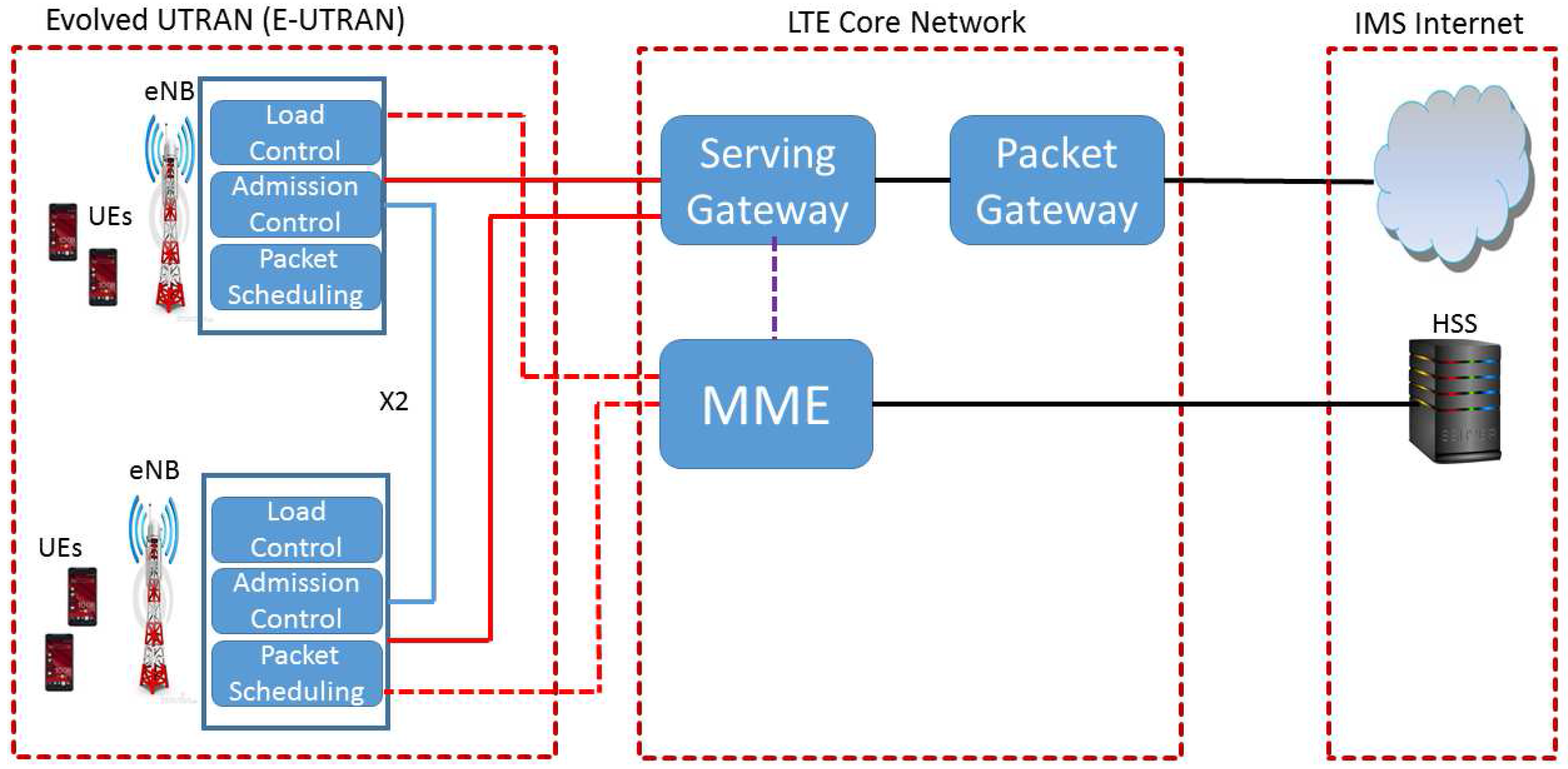
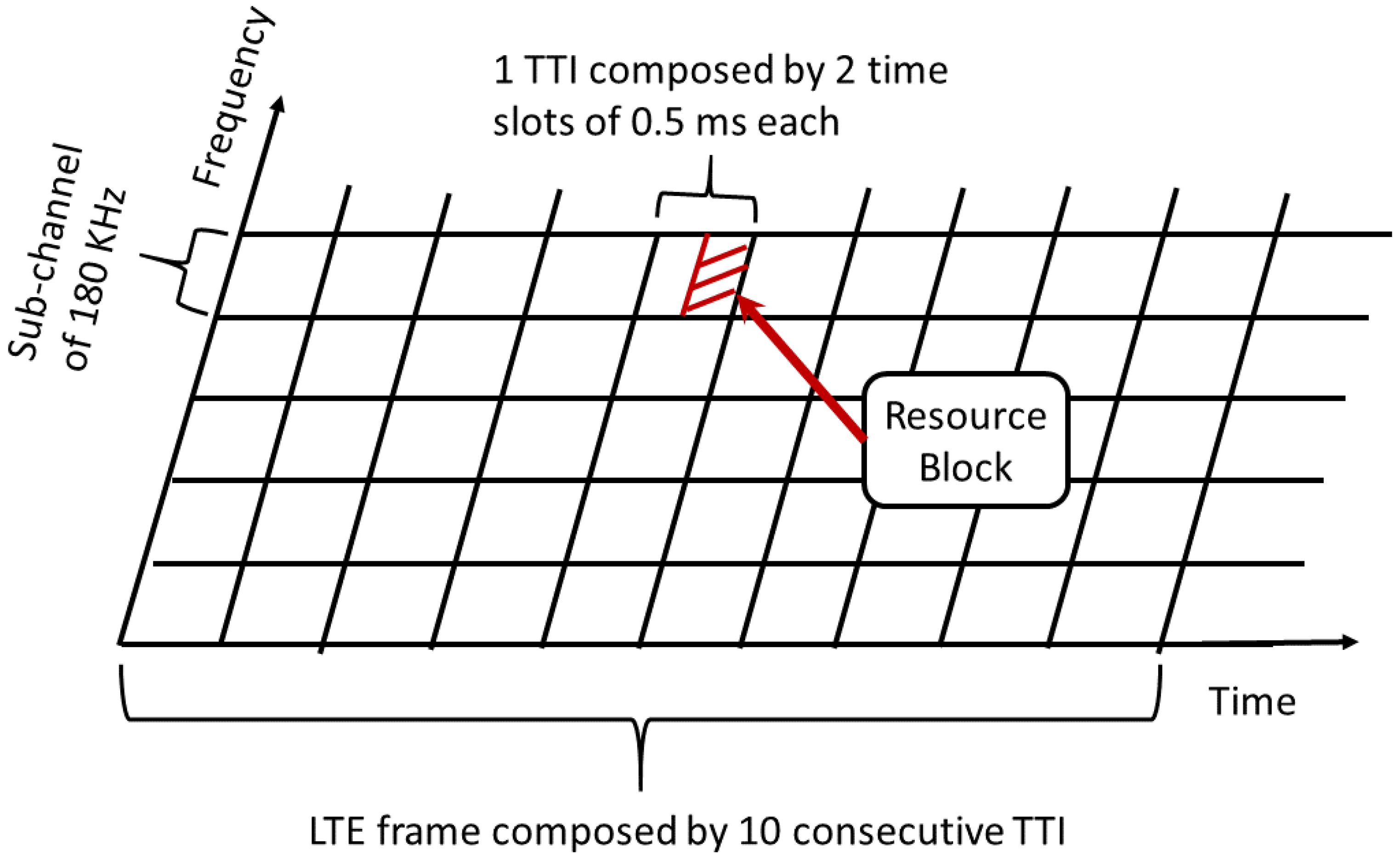
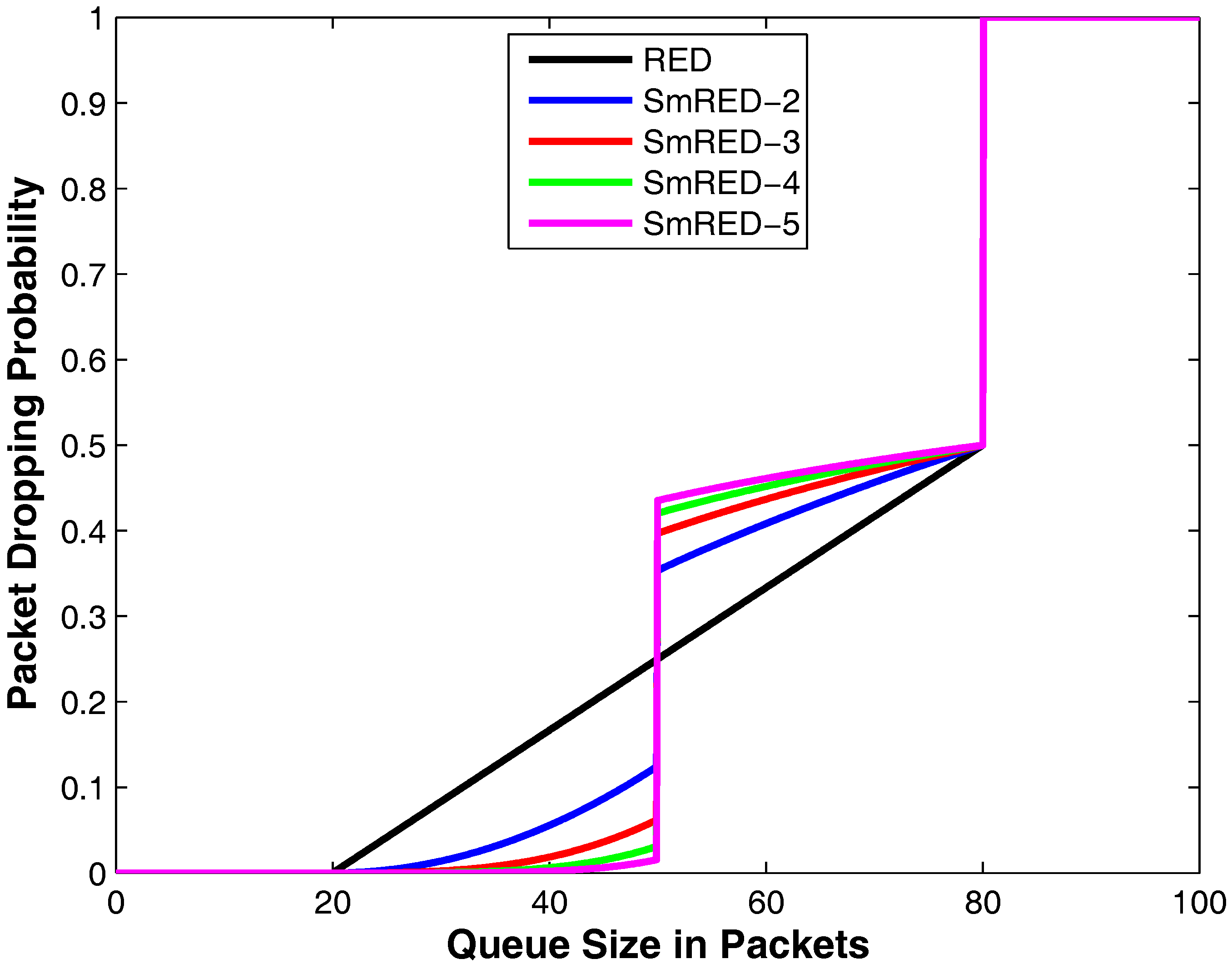

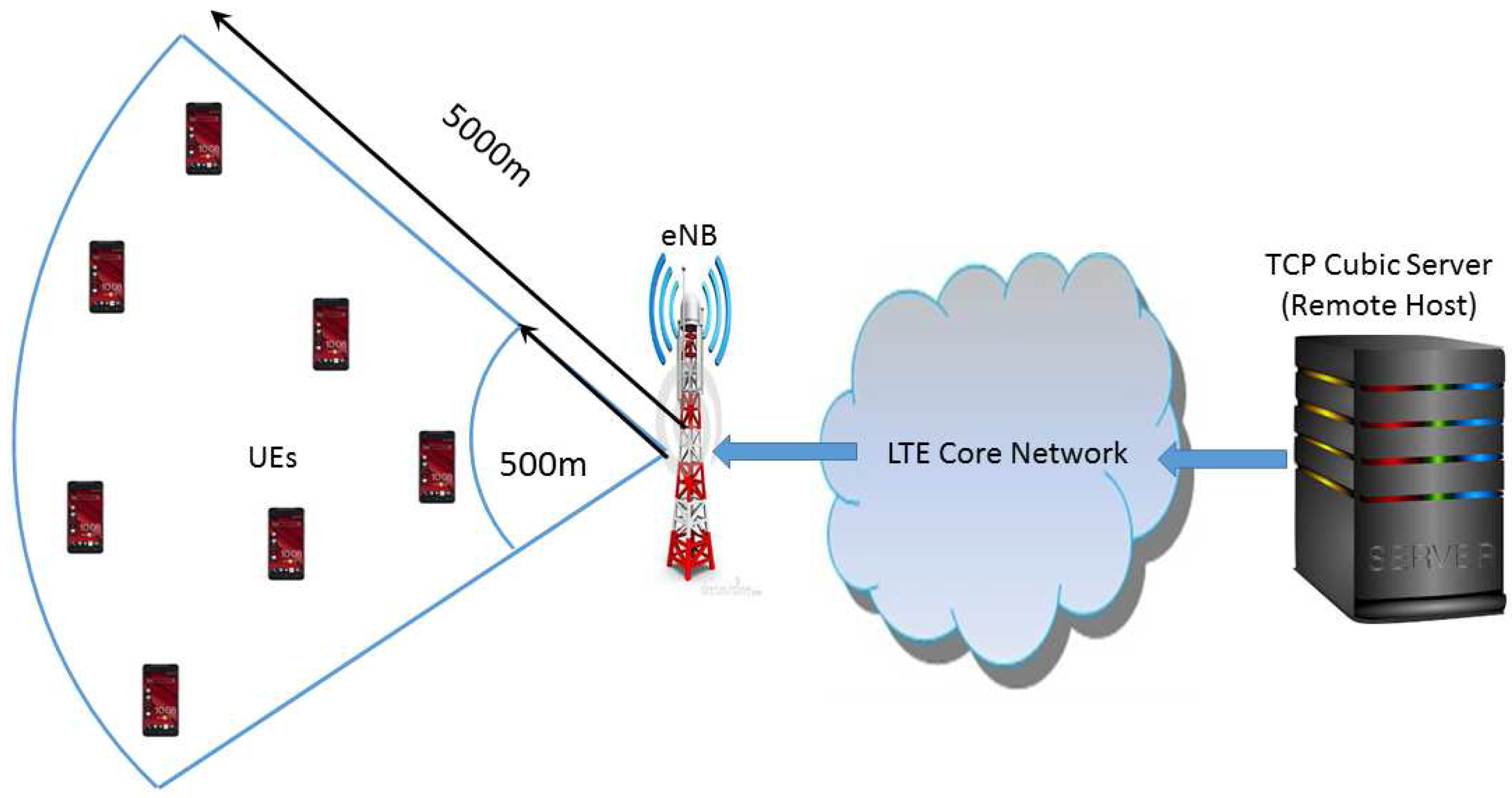
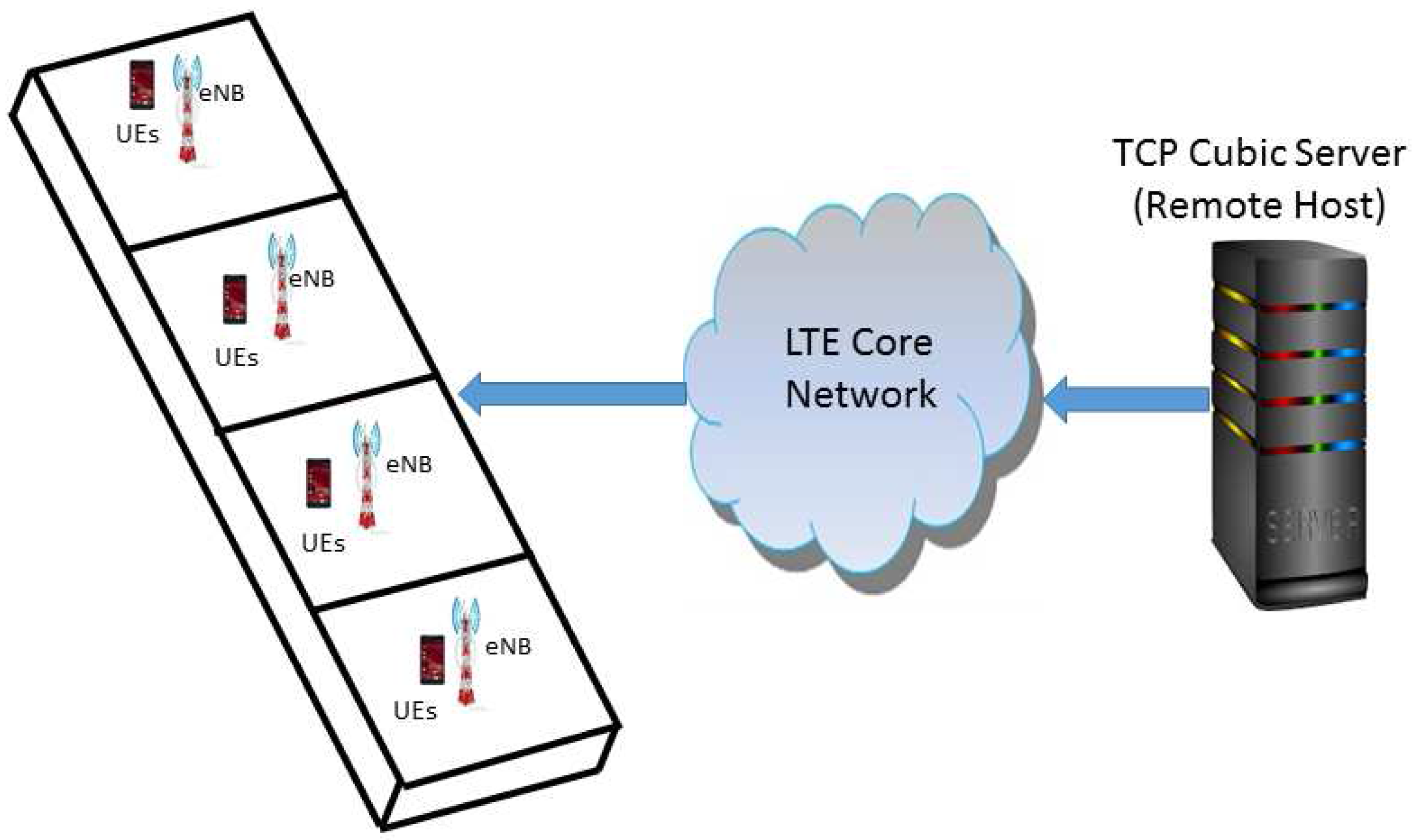

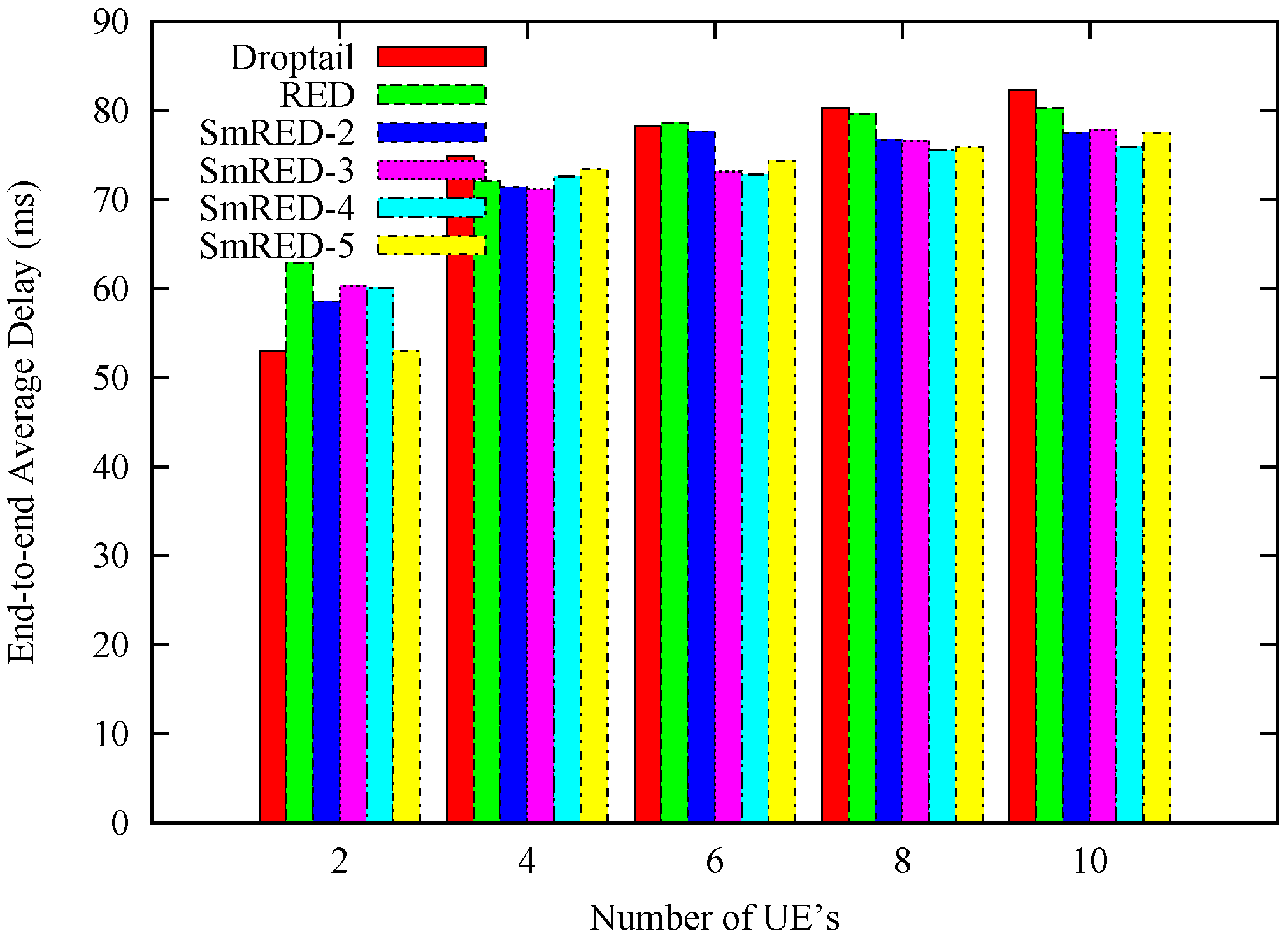
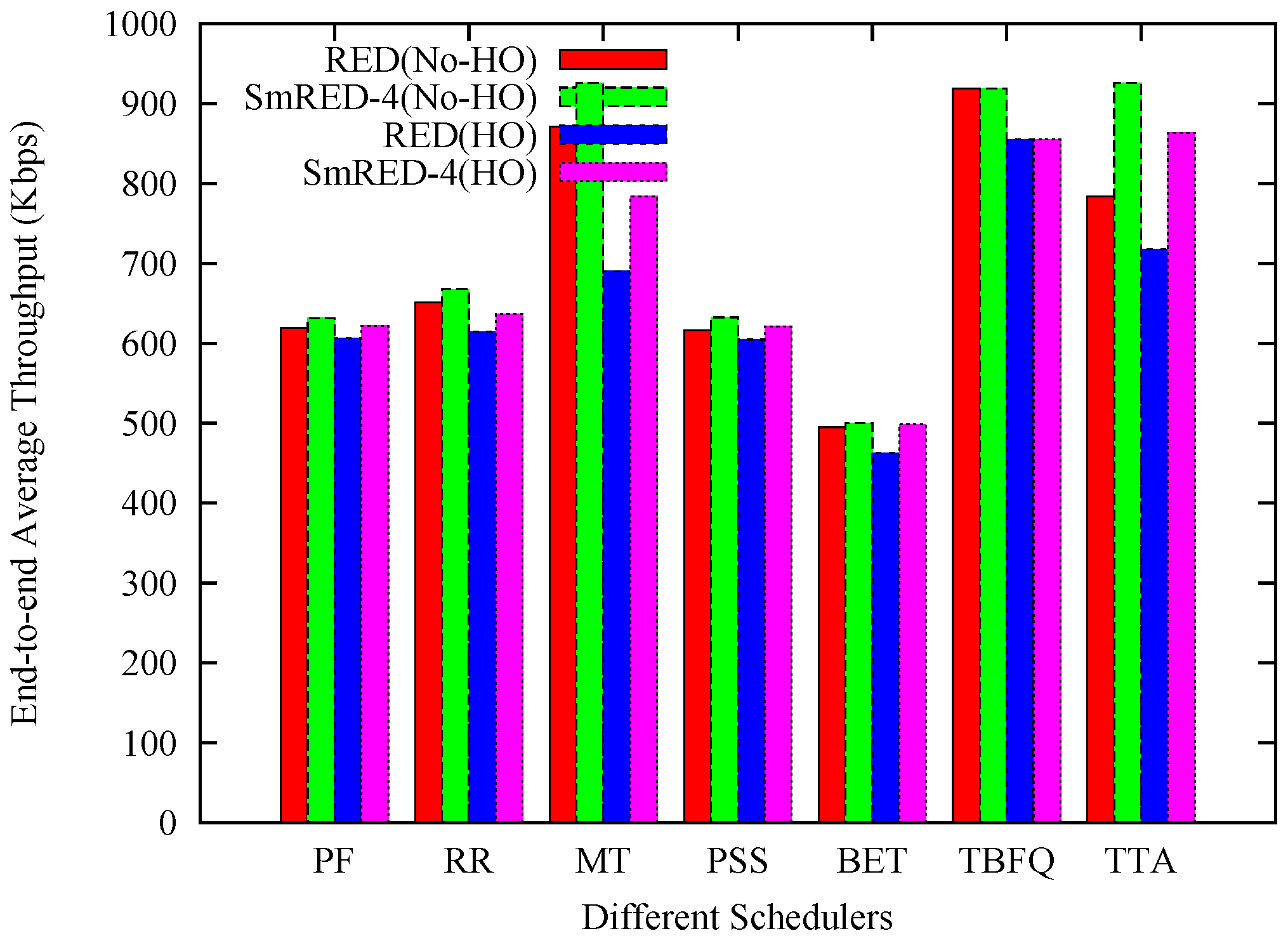
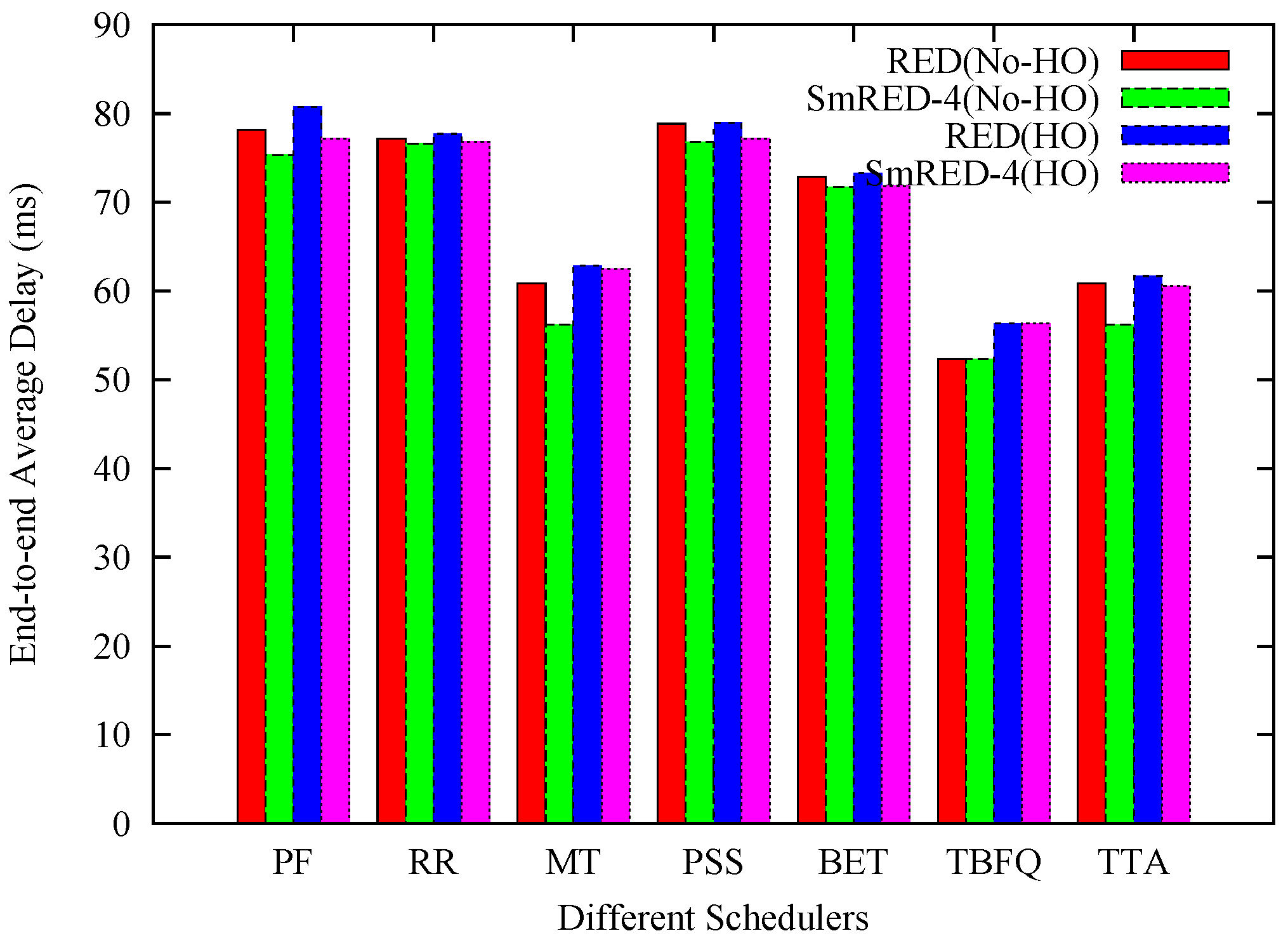

| Simulation Parameter | Value |
|---|---|
| Radio Link Control (RLC) Buffer Size | 100∼200 |
| Number of Traffic Source | 2∼10 |
| Pkt Size | 1000 Bytes |
| Number of Resource Block | 15 |
| Application Data Rate | 100 Mbps (i.e., 1250 Packets/s) |
| Wired Link Capacity | 10 Mbps |
| Wired Link Delay | 50 ms |
| eNB Transmission Mode | SISO |
| Transmission Control Protocol (TCP) Traffic Type | Cubic |
| Handover Algorithm | A3Rsrp |
| Mobility | Random Walk 2D |
| Node Movement Speed | 20 m/s |
| Total Simulation Time | 100 s |
| Application Start Time | From 0.1 s |
| Application Stop Time | 100 s |
| Simulation Area | Single and multi cell with 5 Km Radius |
| RLC Bufer Size | 100 | 125 | 150 | 175 | 200 |
|---|---|---|---|---|---|
| Pkt Loss Rate (RED) in Percentage | 8.98 | 7.01 | 6.18 | 4.48 | 4.29 |
| Pkt Loss Rate (SmRED) in Percentage | 8.31 | 6.80 | 5.31 | 4.27 | 3.98 |
| Reduction Rate in Percentage | 7.50 | 3.05 | 14.05 | 4.68 | 7.22 |
| RLC Bufer Size | 100 | 125 | 150 | 175 | 200 |
|---|---|---|---|---|---|
| Pkt Loss Rate (RED) in Percentage | 5.16 | 4.28 | 4.06 | 3.18 | 3.10 |
| Pkt Loss Rate (SmRED) in Percentage | 3.70 | 3.51 | 2.69 | 2.44 | 2.04 |
| Reduction Rate in Percentage | 28.29 | 17.99 | 33.74 | 23.27 | 34.19 |
© 2017 by the authors. Licensee MDPI, Basel, Switzerland. This article is an open access article distributed under the terms and conditions of the Creative Commons Attribution (CC BY) license (http://creativecommons.org/licenses/by/4.0/).
Share and Cite
Paul, A.K.; Kawakami, H.; Tachibana, A.; Hasegawa, T. Effect of AQM-Based RLC Buffer Management on the eNB Scheduling Algorithm in LTE Network. Technologies 2017, 5, 59. https://doi.org/10.3390/technologies5030059
Paul AK, Kawakami H, Tachibana A, Hasegawa T. Effect of AQM-Based RLC Buffer Management on the eNB Scheduling Algorithm in LTE Network. Technologies. 2017; 5(3):59. https://doi.org/10.3390/technologies5030059
Chicago/Turabian StylePaul, Anup Kumar, Hidehiko Kawakami, Atsuo Tachibana, and Teruyuki Hasegawa. 2017. "Effect of AQM-Based RLC Buffer Management on the eNB Scheduling Algorithm in LTE Network" Technologies 5, no. 3: 59. https://doi.org/10.3390/technologies5030059





